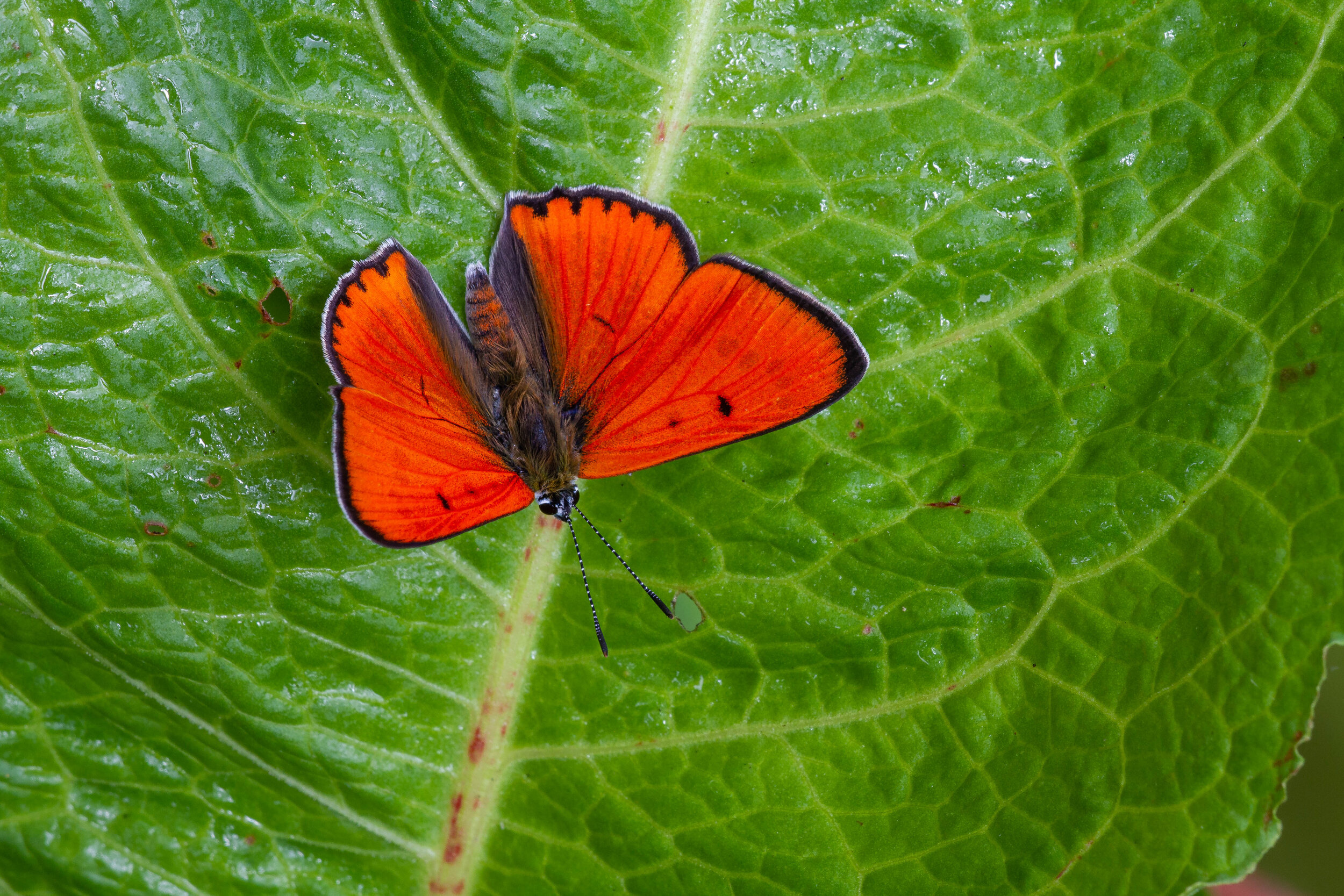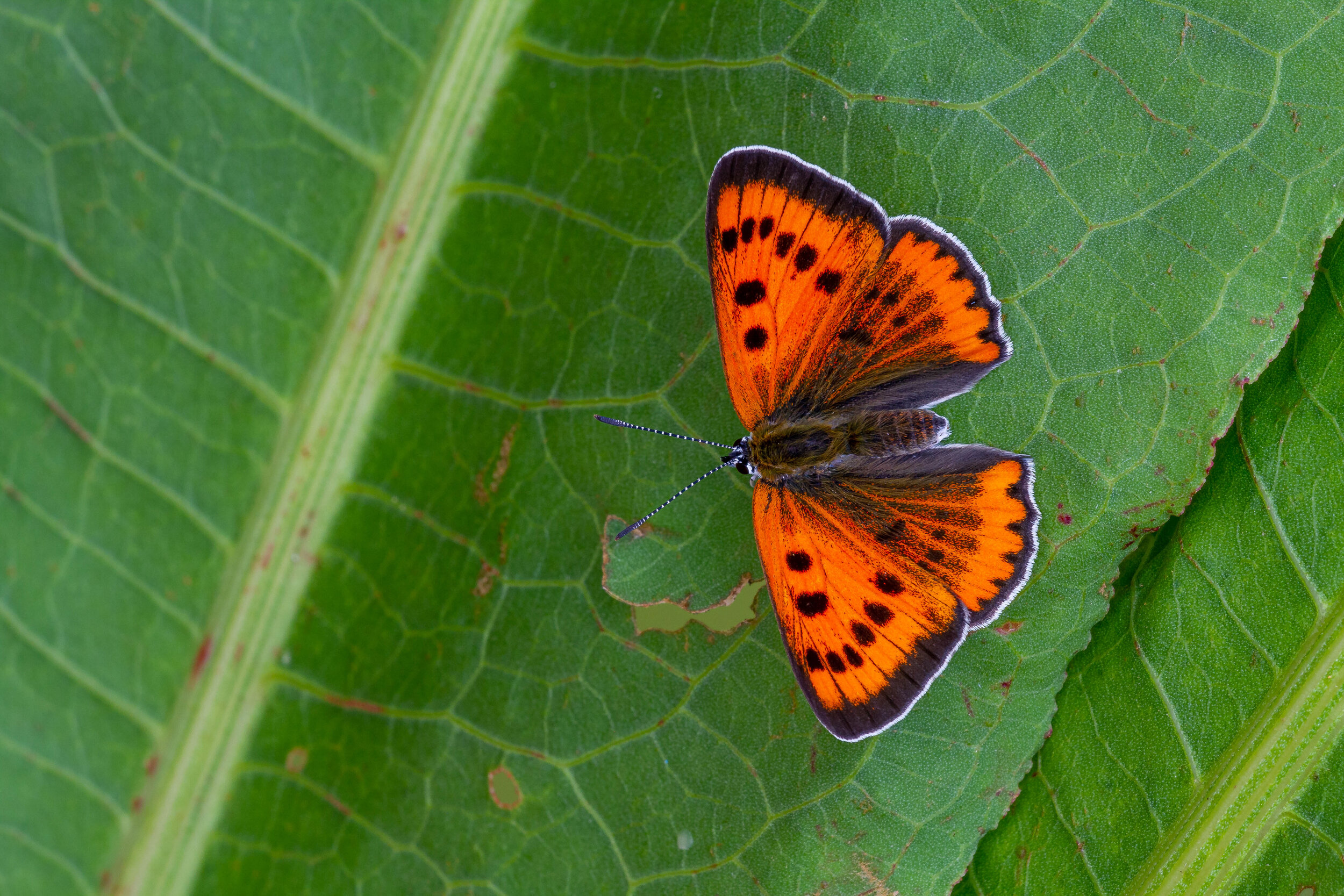Extinction and hope …
“The beauty and genius of a work of art may be reconceived, though its first material expression be destroyed; a vanished harmony may yet again inspire the composer; but when the last individual of a race of living beings breathes no more, another heaven and another Earth must pass before such a one can be again.”
William Beebe (1877-1962)
The above quotation, written by William Beebe the American naturalist, entomologist, ornithologist, marine biologist, explorer and author, has always inspired me. Recent visits to the Hope Department of Entomology at the Oxford University Museum of Natural History (OUMNH) have left me pondering, often with sadness, the ultimate extinction of some species of butterfly from the British Isles and the worrying decline of many others.
Lycaena dispar ssp. dispar. Image copyright © OUMNH.
It is too easy to solely blame collecting for the demise of the Large Copper Lycaena dispar ssp. dispar in Britain; although the irresponsible actions of some early collectors undoubtedly played a very important part in the loss of the subspecies that was endemic to the British Isles (Ford, 1967; Feltwell, 1995). In the case of dispar, the changing fenland management and, in particular, the drainage of the fens, also played significant roles in its demise due to critical habitat loss. This, coupled with the lack of any protected status for the butterfly and its required habitat at that time, pushed the British subspecies into extinction in the Fenlands around 1851 (Dennis, 1977).
Although 1851 is often quoted in text as the date of extinction of L. d. dispar, records exist as late as 1864 (Irwin, 1984, cited in Feltwell, 1995; Asher et al., 2001). These include records as far north as Walkeringham, Nottinghamshire by Miller, and Gainsborough, Lincolnshire by Farrington and Miller (Dennis, 1977). It is also reputed to have ‘definitely inhabited the Somerset marshes’, with a record by Crouch in 1857 (Allan, 1966, cited in Dennis, 1977). Records from other locations also exist.
Lycaena dispar ssp. rutilus. Image copyright © OUMNH.
In 1909, an unsuccessful attempt was made to introduce the continental subspecies L. d. rutilus into Wicken Fen, Cambridgeshire; the main reason for failure being the scarcity of its food plant (Ford, 1967). Several years later, in 1913-14, Captain E. Bagwell-Purefoy successfully introduced rutilus into a snipe-bog at Greenfields, Tipperary in Southern Ireland. This colony existed until at least 1928 (Ford, 1967; Dennis, 1977). With the exception of supplementation of adults in 1926 and 1943 from Dutch stock, the colony was self-sustaining. It was last observed in 1954 (Lavery in litt., cited in Emmet and Heath, 1989). 1926 also saw an attempt to introduce rutilus to a marsh in Norfolk, the stock coming from Ireland. This colony only survived for several years as conditions, once again, proved unfavourable (Ford, 1967).
In 1915, a new race of the Large Copper L. d. batavus was discovered in Friesland, Holland. Sadly, due to drainage schemes and irresponsible collecting after its presence was made known, it was on the verge of extinction within a few years (Ford, 1967).
Morphologically, batavus is far more comparable to dispar than rutilus (Frohawk, 1934; Ford, 1967; Thomas and Lewington, 2010). It was therefore decided that every effort would be made to stock Woodwalton Fen with this form; the first butterflies being released in 1927. Due to the early signs of success, a further release was made at nearby Wicken Fen in 1929-1930 (Ford, 1967; Dennis, 1977); though this colony only survived for around 12 years after an adjacent fen was reclaimed for agriculture (Duffey, 1974, cited in Feltwell, 1995). The colony at Woodwalton continued to prosper for many years, though was regularly supplemented with captive-bred stock. Despite fresh stock being introduced, along with regular caging of the larvae in order to provide a level of predatory protection, the colony was finally lost in 1969. Several further reintroductions were made until the programme was stopped during the 1990s (Thomas and Lewington, 2010).
Lycaena dispar ssp. batavus. Image copyright © OUMNH.
Unfortunately, in Britain, all reintroduction attempts to date have ultimately ended in failure, though much has been learnt. In the Netherlands, batavus had shown a welcome recovery following a successful fen management programme (Thomas and Lewington, 2010). However, recent trends indicate they are now at a very low level. In Britain, the Great Fen project may shed a ray of hope on the future of the Large Copper in its former habitat. This ambitious 50-year project aims to create a huge wetland area comprising some 3,700 hectares (9,143 acres), between Peterborough and Huntingdon. It is destined to be one of the largest wetland restoration projects of its type in Europe. It encompasses both Holme Fen and Woodwalton Fen, two of the Large Copper’s most famous historic breeding grounds. So maybe all is not lost and, one day, in the hopefully not too distant future, we may see a successful reintroduction programme of the Large Copper in Britain.
So what does this tell us?
Even after three good years (2018-2020), population levels of so many butterfly species continue to be down compared to 40 years ago, with just under a third of butterfly species assessed in the UK showing long-term declines. We need to be very wary of shifting baseline syndrome, whereby we forget, or never experienced, the greater biodiversity that occurred in the UK in former decades and therefore lower our expectations and aspirations for conservation (Butterfly Conservation, 2021; UK Butterfly Monitoring Scheme, 2021).
We must highly value and protect what we have. We must continue to research and keep learning ensuring effective understanding, communication and collaboration between conservation bodies and those who may have a different opinion, perspective, insights and experience. We may only have 59 regularly occurring species of butterfly in the UK but there is still much we do not know. We must learn from our successes and we must learn from our mistakes. We must educate and we must conserve. We have a responsibility.
My thanks to Darren Mann and James Hogan at OUMNH for their assistance in providing access to specimens within the British collection. With special thanks to Katherine Child for her photographic and design skills. Also, thanks to Peter Eeles for the images of batavus and his continued friendship, enthusiasm and support.
References:
Asher, J., Warren, M., Fox, R., Harding, P., Jeffcoate, G. and Jeffcoate, S. (2001). The Millenium Atlas of Butterflies in Britain and Ireland. Oxford: Oxford University Press, pp. 140-143.
Butterfly Conservation. https://butterfly-conservation.org/news-and-blog/2020-hailed-as-a-good-year-for-butterflies [Accessed, 2nd April 2021].
Dennis, R.L.H. (1977). The British Butterflies - Their Origin and Establishment. Faringdon, Oxon: E.W. Classey Ltd, pp. 97-100, 104.
Emmet, A.M. and Heath, J. (1989). The Moths and Butterflies of Great Britain and Ireland. Colchester Essex: Harley Books, 137-139.
Feltwell, J. (1995). The Conservation of Butterflies in Britain (past and present). Battle, East Sussex: Wildlife Matters, pp. 55-69.
Ford, E.B. (1967) (reprinted). Butterflies. London: Collins (New Naturalist), pp. 142, 166-169.
Frohawk, F.W. (1934). The Complete Book of British Butterflies. London: Ward, Locke & Co., pp. 260-268.
Great Fen Project. http://www.greatfen.org.uk [Accessed, 2nd February 2013].
Thomas, J. and Lewington, R. (2010). The Butterflies of Britain & Ireland. Gillingham, Dorset: British Wildlife Publishing, pp. 101-104.
UK Butterfly Monitoring Scheme. https://ukbms.org [Accessed, 2nd April 2021].




